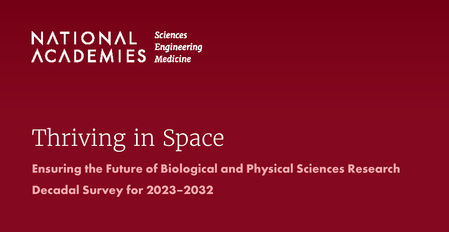Every ten years, the National Academy of Sciences conducts a study of particular areas of space research and makes findings and recommendations. The latest version of Thriving in Space: Ensuring the Future of Biological and Physical Sciences Research: A Decadal Survey for 2023-2032 (2023), hereinafter referred to was the Survey. is being unveiled. While the final version is not yet out, Sustainspace has viewed a substantial-finished preprint and presents several important part of the report related to space life support, plant research, and sustainability.
Life Support
Let’s cover life support first. The Survey recommends a general change from individual research projects to research campaigns for NASA’s Biological and Physical Science (BPS) Division. “Research campaigns would be a new approach at the BPS Division” and that “NASA should pursue dedicated research campaigns that, through the coming decade, will drive solutions to specific groups of key scientific questions” (p. 6). The campaign most related to life support would be “BLiSS (Bioregenerative Life Support Systems) to build and understand the systems that would provide high-quality food, refresh air and water, process wastes, and enable the creation of space environments sustainable for long periods of time independent of Earth” (p. 7). This campaign is motivated by part of Survey Finding 6-1 (p. 168–169). Note that “the potential for biological and physical sciences (BPS) research access specifically to Starship was not incorporated in the technical risk and cost evaluations of the BLiSS” due to “due in part to the associated uncertainties in development, deployment, and access by BPS researchers” (p. 171).
Further details are found in this excerpt of the Survey:
BLiSS is targeted to build sufficient knowledge of the biological systems, interactions, and systems of systems to provide high-quality food, refresh air and water, process and valorize wastes, and enable the creation of space environments sustainable for long periods of time independent of Earth. Sustainable bioregenerative life support has been a science goal for many decades and is encompassed within NASA’s technology roadmap, which states that self-sufficient life support systems are crucial for sustaining life and mitigating negative physiological effects on long-duration missions. This campaign seeks to understand the multiple biological phenomena at play while providing a distinct technology gain for space exploration and also presenting high return-on-investment for development of sustainable technologies for Earth. (p. 7)
The BLiSS research campaign focuses on four high-level goals:
Develop self-sustainable biological life-support systems that produce food, clean water, renew air, process waste, and create critical materials to meet the challenges of long-duration space missions.
Harness beneficial properties of plants and microbes that will enable humans to live in space, independent of resupply from Earth.
Create a highly functioning, robust, and resilient ecosystem and space environment that is self-sustainable under extraterrestrial radiation and gravity conditions.
Enable long-duration (>3 years) exploration of deep space by providing a fully or partially closed–loop biological life-support system.
Hence the Survey targets capabilities for science and exploration mission to the Moon, Mars and deep space rather than for longer-term human settlements in space, “accepting that a full closed-system capability is unlikely to be achieved by the end of the decade” (p. 172). So this campaign will focus upon the production of vitamins and food, water purification, air revitalization, and recycling of waste stream (p. 172). The Survey describes Earth” as a worldwide BLiSS research campaign” (p. 173), raising Earth sustainability implications.
Plant Research and Growth
The Survey also delves into plant research and food growth. The Survey observes that:
The space environment provides unique opportunities for fundamental plant sciences, as distinct from applied studies that may be concerned with cultivation of plants for life support in space. The study of green plants in microgravity and partial gravity environments encountered in space enables the interrogation of scientific questions that cannot be investigated on Earth (p. 12).
The Survey further observes that:
Moving beyond LEO, the need to grow plants for lunar and Mars missions will require new types of plant growth facilities, optimizing plant growth, and selecting or engineering traits optimized for growth on supplemented lunar or martian regolith and under altered gravitational conditions and within the complex microbiome of space vehicles and habitats” (p. 23).
Yet the Survey does not call for any specific new plant growth hardware in space, instead, relying on mere refreshes of existing chambers such as the Advanced Plant Habitat and VEGGIE. While this may reflect budget realism, it is certainly inconsistent with other goals.
Sustainspace Opinion: many more plant growth chambers are required to meet the identified research and life support goals, and also to support commercial agriculture research in space. A greater variety of chambers is also needed to handle a greater range of plants.
Call For Order of Magnitude of Funding Growth
The Survey asserts that much more funding will re required to meet NASA’s goals as regards life support improvements and BPS research. The Survey observes that “During the space shuttle era, funding for the equivalent NASA division was approximately eightfold higher than current funding within NASA (NASEM 2018)” (p. 3). It finds that “The BPS program is severely underfunded relative to current need, essentially preventing the development of a truly robust and resilient program that can meet the space exploration science needs of the nation (p. 3).” This is also Finding 10.
They recommend that “NASA should establish support for the Biological and Physical Sciences Program to levels that reflect the current national need and to build the science community in size, diversity of technical expertise and lived experience, and capability to reach the science goals of the nation, toward levels that are an order of magnitude above the current funding and well before the end of the decade (p. 4).” This is also Recommendation 9.
Sustainspace Opinion: We agree with this finding and recommendation, and have informally called for the same based upon our own analysis.
Reference
National Academy of Sciences (2003), Thriving in Space: Ensuring the Future of Biological and Physical Sciences Research: A Decadal Survey for 2023-2032.

